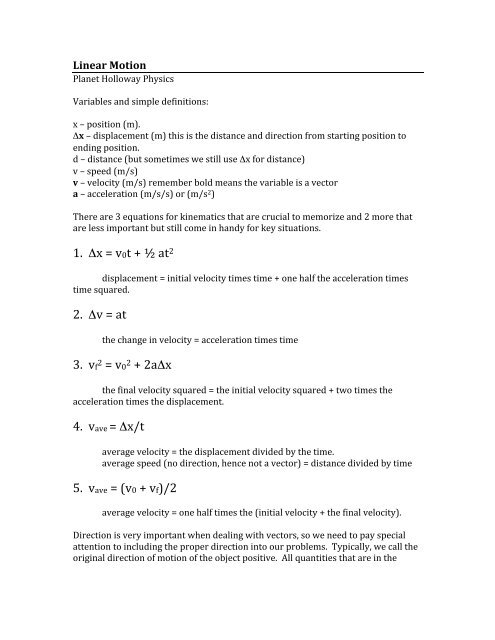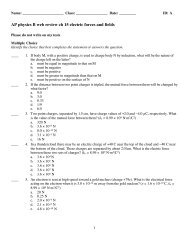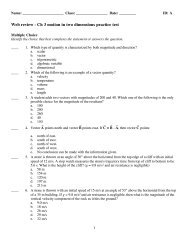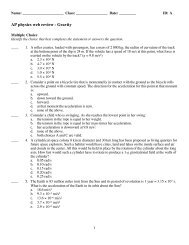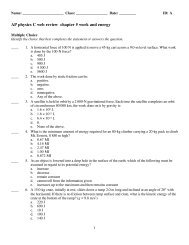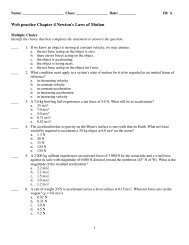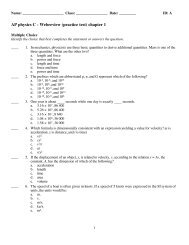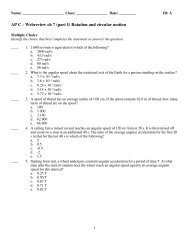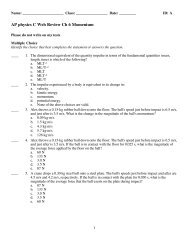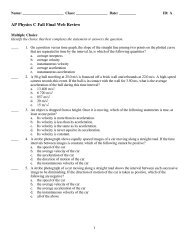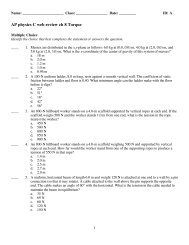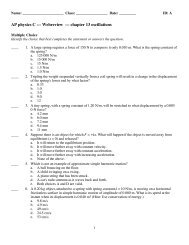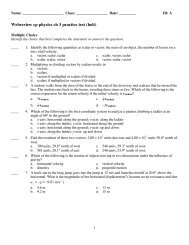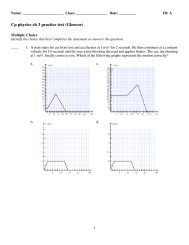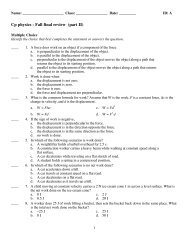v0t + ½ at 2 Δv = at 3 vf = v0 + 2aΔx 4 vave = Δx/t 5 vave = (v0 + vf)/2
Chapter 2 (pdf) - Planet Holloway
Chapter 2 (pdf) - Planet Holloway
Create successful ePaper yourself
Turn your PDF publications into a flip-book with our unique Google optimized e-Paper software.
Linear Motion<br />
Planet Holloway Physics<br />
Variables and simple definitions:<br />
x – position (m).<br />
<strong>Δx</strong> – displacement (m) this is the distance and direction from starting position to<br />
ending position.<br />
d – distance (but sometimes we still use <strong>Δx</strong> for distance)<br />
v – speed (m/s)<br />
v – velocity (m/s) remember bold means the variable is a vector<br />
a – acceler<strong>at</strong>ion (m/s/s) or (m/s 2 )<br />
There are 3 equ<strong>at</strong>ions for kinem<strong>at</strong>ics th<strong>at</strong> are crucial to memorize and 2 more th<strong>at</strong><br />
are less important but still come in handy for key situ<strong>at</strong>ions.<br />
1. <strong>Δx</strong> = <strong><strong>v0</strong>t</strong> + <strong>½</strong> <strong>at</strong> 2<br />
displacement = initial velocity times time + one half the acceler<strong>at</strong>ion times<br />
time squared.<br />
2. <strong>Δv</strong> = <strong>at</strong><br />
the change in velocity = acceler<strong>at</strong>ion times time<br />
3. <strong>vf</strong> 2 = <strong>v0</strong> 2 + <strong>2a<strong>Δx</strong></strong><br />
the final velocity squared = the initial velocity squared + two times the<br />
acceler<strong>at</strong>ion times the displacement.<br />
4. <strong>vave</strong> = <strong>Δx</strong>/t<br />
average velocity = the displacement divided by the time.<br />
average speed (no direction, hence not a vector) = distance divided by time<br />
5. <strong>vave</strong> = (<strong>v0</strong> + <strong>vf</strong>)/2<br />
average velocity = one half times the (initial velocity + the final velocity).<br />
Direction is very important when dealing with vectors, so we need to pay special<br />
<strong>at</strong>tention to including the proper direction into our problems. Typically, we call the<br />
original direction of motion of the object positive. All quantities th<strong>at</strong> are in the
original direction of movement are listed then as positive and all th<strong>at</strong> point the<br />
opposite direction are listed as neg<strong>at</strong>ive.<br />
For example, when a ball is thrown up, we say the original velocity (which is<br />
upward) is positive and the acceler<strong>at</strong>ion due to gravity is neg<strong>at</strong>ive (because it<br />
always points down.<br />
Some things to remember:<br />
On a position vs. time graph, the slope of a section or point is the velocity. The<br />
steeper the slope, the gre<strong>at</strong>er the velocity. When the slope is positive, the velocity is<br />
positive and when the slope is neg<strong>at</strong>ive, the velocity is neg<strong>at</strong>ive.<br />
On a velocity vs. time graph, the slope of a section or point is the acceler<strong>at</strong>ion. The<br />
steeper the slope, the gre<strong>at</strong>er the acceler<strong>at</strong>ion. When the slope is positive, the<br />
acceler<strong>at</strong>ion is positive and when the slope is neg<strong>at</strong>ive, the acceler<strong>at</strong>ion is neg<strong>at</strong>ive.<br />
On an acceler<strong>at</strong>ion vs. time graph, the area under the curve is the change in velocity<br />
of the object. If the area is above the x axis, then the change is positive and if it is<br />
under the x axis, the change is neg<strong>at</strong>ive. For the total change for a given interval,<br />
simply add the areas (both positive and neg<strong>at</strong>ive).<br />
On a velocity vs. time graph, the area under the curve is the change in position or<br />
displacement of the object. The conditions are the same as above.


